![]()
![]()
![]()
Use LEFT and RIGHT arrow keys to navigate between flashcards;
Use UP and DOWN arrow keys to flip the card;
H to show hint;
A reads text to speech;
52 Cards in this Set
- Front
- Back
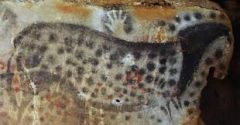
|
"Spotted Horses and Human Hands" -Time: Paleolithic 3000-2000 BCE -In cave at dordogne, France
-used natural canvas, used tar like material for paint with animal fat |
|

|
"women of Willendorf" -midsection is emphasized -reproductive features are also emphasized -perhaps made as good luck charms in that reproduction was dangerous at this time
vienna Austria
|
|

|
"Wall Painting with HorsesRhinoceroses, and Aurochs"
Chauvet Cave, ca. 30, 000 , 28, 000 B.C. paint on limestone
destroyed bc of tourist
Discovery in 1994 (remember Paleolithic period) successful hunt, initiation right, increase animal population) |
|
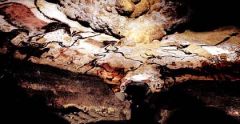
|
"Hall of Bulls" Lascaux, France -france c. 1500 bc, paint on limestone |
|
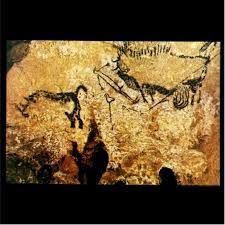
|
"Bird headed man with bison" Lascaux, France. Paint on limestone
only human like image during time period, but it has a bird head
|
|
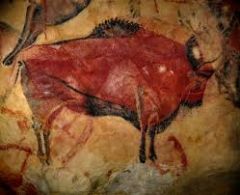
|
"Bison" from Altamira, Spain Medium: round mineral pigment, used animal fat to apply pigment to wall with fur pads, sticks, blow tubes (airbrush)
great example of medium use: artist uses the bends of the round rock to make the bison look more realistic |
|
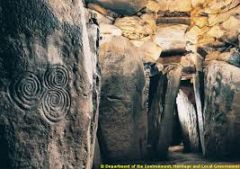
|
"Tomb Interior" Newgrange Ireland -built as tomb -stone entrance to passage
mosoleim build into rocks
neolithic period
|
|
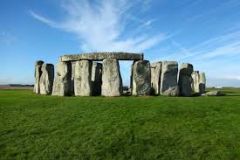
|
"Stonehenge" Wiltshire England -perhaps used for religious purposes -during summer solstice if you stand in center you will be looking at exact spot where sun rises- marks agricultural part of year. calender clock
POST AND LINTEL
blood because of sacrifice
stones are not from the era
neolithic period |
|
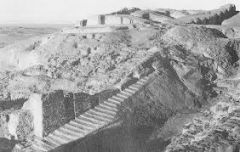
|
"ruins and plans of white temple" Warka Iraq
-large center hall and small side room -meant for a select few of people |
|

|
"carved Vessel" (Uruk Vase) Iraq national museum, Baghdad
3 registers (one story line) , telling 3 stories
celebrating a group or an individual |
|
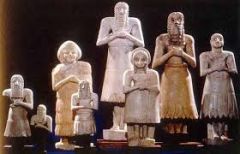
|
"votive statues from the square temple" black Limestone, gypsum, University of chicago
Subject: -each statue has a little cup for a religious practice (they were there to pray on my behalf for Gods to see)
-male figure identified as Abu (vegetation God) has the largest eyes (most reconizable features)
SUMERIAN
|
|
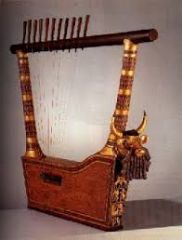
|
"Great Lyre with Bulls Head"
royal tomb at Ur. Wood with gold, silver, lapis lazuli (bright blue stone) bitemen and shell reassembled on a modern wood support, University of PA museum
Subject: -animals dancing, no humans -a story is being told, gets more important as the eyes go up |
|
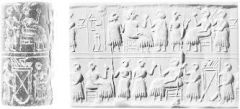
|
Cylinder seal and modern impression for identifying an item of personal belonging, its like a stamp
Culture: Sumerians credited for first writing system
Medium: Lapis lazuli |
|

|
Nanna Ziggurat,
Ur (present day Iraq) 2100-2050 BCE, fired brick. ziggurats were commonly used for religious purposes -formal realistic structure with a verticle stairway (not a staircase on both edges)
mesopotamian
|
|
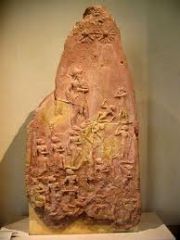
|
"stele of naramsin" Limestone, louvre, paris. Names: Shamash and Ishtar Horned helmet: usually an attribute of a god -two stars which a represented to two Gods shamash (sun god) and ishtar (goddess of fertility) -stele(stelea) is any carved monument that celebrates an individual or event -most important figure is the largest
Pictoral composition: Gods are much bigger than the people of less hierarchy
Akkadian mesopotamian |
|
|
Quality of mesopotamian sculpture: Style |
-large eyes -pronounced eye brow -very contained, formal and stiff looking -frontal arms are front, legs are front
-almost always seen in profile -no sense of depth- very flat |
|
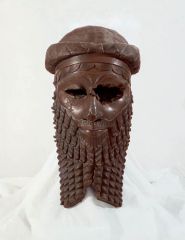
|
"head of a man" Akkadian ruler From nineveh, c 2300-2200 BCE copper, Iraq National Museum, Baghdad Copper.
eyes that are gone: because they were probably worth something and someone stole it
|
|
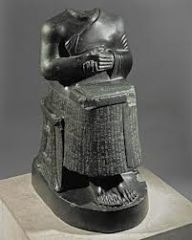
|
"votive statue of gudea" Lagash (ruler of Lagash, c. 2090, diorite, Louvre, Paris. -tried to bring back sumeritian ideas as a leader -known for temple rehabilitation
head is gone, cunieform is on the side
|
|
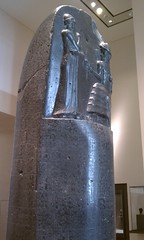
|
"stele of Hammarabi" babylonian c 1792 Bc, diorite, louvre, Paris. Name: Shamash
-the laws of hammurabi are carved into the stone- very harsh rules- brought together parts of middle east most known ruler of time period
|
|

|
"Assurnasipal II killing lions" -Assyrian from the Palace of assurnasipral, Kalhu c 875, alabaster, British Museum, London.
-controlled hunt: aimed to harm instead of a hunt. this is their idea of hunt
|
|
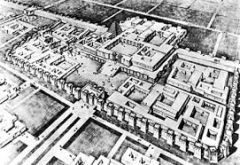
|
Reconstruction drawing of the Citadel of Sargon II
fortified walls for protection
assyrian
|
|
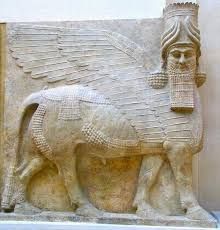
|
Guardian Figures, Citadel of Sargon II, Khorsabad, Iraq
assyrian
when you walk up to it, its suppose to provoke fear |
|
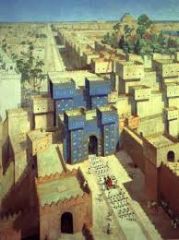
|
reconstruction drawing of babylon in the 6th century bce Name: Nebuchadezzner
Babylon being redone
best way to stop an army: is creating a tiny little opening so only a few people can get through |
|
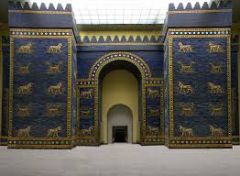
|
Ishtar Gate the eighth gate to the inner city of Babylon.
lots of animals are shown
Dedicated to the Babylonian goddess Ishtar, the gate was constructed using glazed brick |
|
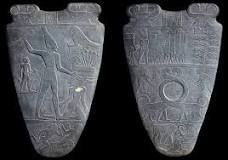
|
palette of Narmer
old kingdom egypt
bowling pin guy with falcon ( horus)
reps unifying lower and upper egypt
very shallow relief carving
most important figure is the tallest
reps a figure to be used for 3000 years
solid ground line
egyptian DID NOt use or understand prospective.
Stone relief Removed his shoes because of sacred event White crown of upper egypt Horus: falcon god Papyrus and human head City of lower egypt Hathor: Cow goddess, nurses infant king and protects Frontal eye and profile head |
|
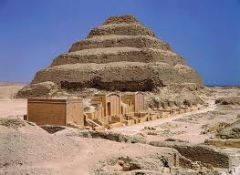
|
Stepped Pyramid of Djoser, Saqqara, limestone
oldest egyptian pyramid
Djoser is the second king of the egytian old kingdom, temple is for him
shows worship and after life
Imatept is the arcitect |
|

|
Great Pyramids and Sphinx, Giza granite and limestone names: Khfu(tallest 450 ft) , Khafre and Menkaure (three kings that the pyramids were built for) Term: ben stone Ra; sun god Great Sphinx, from the funerary district of khafre giza, sandstone |
|
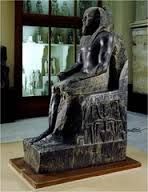
|
Khafre,
from his Valley Temple, Giza, Diorite, Egyptian Museum, Cairo . Terms: Horus, lotus and papyrus Portraiture: more perception than truth
idealizes kings presence |
|
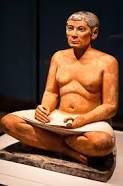
|
Seated Scribe Scribe to the dead heiroglyphics
|
|
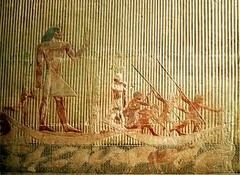
|
Ti Watching a hippopptamus Hunt, at the tomb of Ti, Saqquara, painted limestone Hippo was considered a dangerous creature
produced for enjoyment of the deseized in his tomb
After life
profile view of straight chest |
|

|
Rock-cut Tombs, Beni Hassan
Middle kingdom Egyptian Art
structured like this because they didnt want people stealing their stuff
|
|

|
Funerary Mask of Tutankhamen New kingdom Egypt
his mom and dad were brother and sister
had a form of epilepsy, when he fell, he died instantly
hes very popular because his tomb was not found until 1922 and it was very in tact.
sold gold with emerald pearls, diamonds, rubys |
|

|
Great Temple of Amun, Karnak
Pylons, open courtyards, hippastyle hall
2 images: plan and detailed image of columns (could be interior view of the columns instead of whole view)
new kingdom egypt |
|
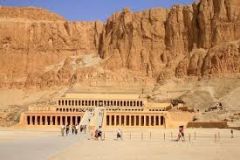
|
Funerary Temple of Queen Hatshepsut, Deir el-Bahri
new kingdom egypt
cut into rock
|
|

|
Colossal Figure of Akhenaten mid 14th C BCE sandstone with traces o paint, Egyptian museum, Cairo.
new kingdom egypt
challenged religion: said monotheism
changed the way people looked, wanted to bring the characterisics that people had into art - embrace who we are (some of this stuck) |
|

|
Akhenaten and his Family =playful, lovely image
new kingdom egypt
celebrated one egyptian blessing god
|
|

|
Nefertiti painted limestone, staatlilche meuseen zu Berlin -unfinished, perhaps created to serve as a model -most of her still in tact -rubys were crushed up and used as pigment
wife of akhenaten |
|

|
Inner coffin of Tutankhamun
his tomb remained largely in tact until 1922
reps wealth of new kingdom egypt |
|
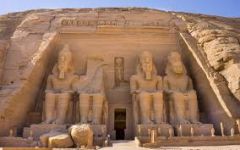
|
Temple of Ramses II, Abu Simbel Ramses was interested in advancing society
|
|

|
Judgment of Hunefer Before Osiris
* Osiris (enthroned wearing Atef crown; he is associated with death and is one of the most powerful gods in the Egyptian pantheon) biggest person - profile view
after life |
|

|
Aegean art: Cycladic, late Neolithic, early Bronze Age 4-2
Figure of a Woman
very simple of its form- reps any women |
|

|
Reconstruction drawing of the “Palace” Complex of Knossos, Crete
minonoan
on an island, defense |
|

|
Stairwell, Knossos
falsk: big storage for liquids |
|

|
Harvester Vase Mineoan agean art
Black Steatite
ritual use: celebrates great harvest
|
|

|
Octopus Flask
Aegean art: minonan= sea life
Marine style because they depicted sea life on their surfaces. This Octopus flask from around 1500 BC celebrates the oceans.
ceramic
kamaresware
|
|

|
Vapheio cup
minoan style vessel, founded in greek main land, traveled or part of trade
style is much in common with fresco pottery found in palace |
|

|
Citadel, Mycenae fortifiecation: giant defensive wall that would keep you out |
|
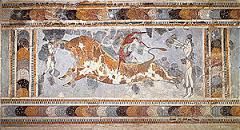
|
Bull leaping
curving imagery that was typical of this time period wasp and tiny waits features
example of fresco painting |
|

|
LIon Gate, Mycenae
reliefing triangle post and lintel corbelling: a little bit further each time until you come to a point |
|
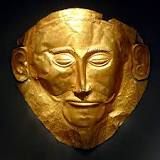
|
“Mask of Agamemnon”
pure gold
idealized but still has his own characteristics
put mask on for sleeping
after life |
|

|
dagger blade
mycenians=hunters on main land
theyres animals |
|
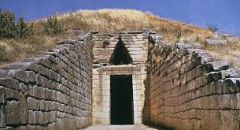
|
treasury of atreaus (tholos)
interior and posterior
beehive corbelling
mycenean |

